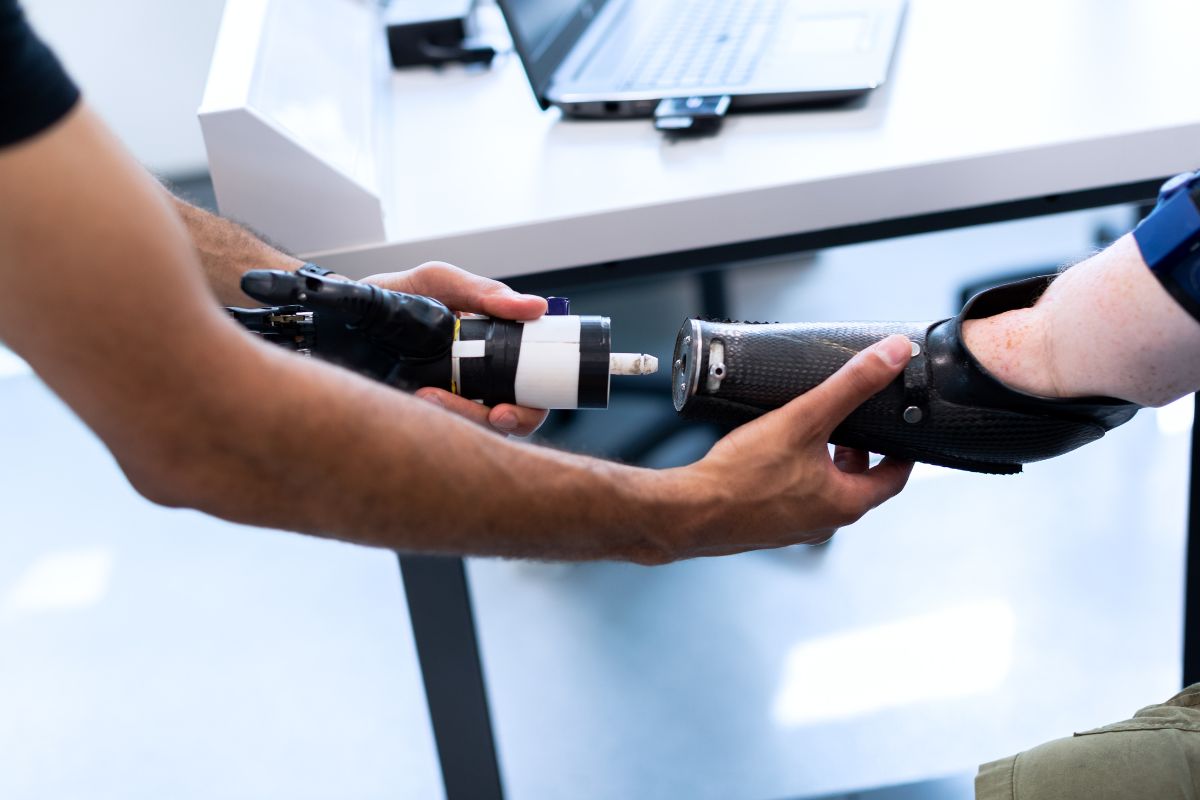Hand Transplantation v/s Prosthetic Limbs How do we decide?
Anyone who has faced amputation of a limb, he/she knows the pain that they have to go through. All the things that they used to do previously soon become a nightmare. However, with the advancements in medical technology, you now have reasonable options which can provide hope to many.
The options for functional rehabilitation after a hand amputation are few. Traditionally, patients have always been counselled to use an artificial or a prosthetic limb. The decision to perform a hand transplantation is complex. It involves considerations of eligibility, surgical procedures, postoperative care, functional outcomes, and psychological and ethical implications. In this blog, Dr. Nilesh Satbhai delves into the benefits and risks of these two approaches, providing a comprehensive comparison for a nuanced understanding.
Overview of Hand Transplantation
Eligibility Criteria for Hand Transplantation
Hand transplantation involves stringent eligibility criteria, considering the level and extent of amputation, the recipient’s age and health, motivation, and donor availability. This surgery is not without its challenges, as finding a suitable donor can be difficult and time-consuming. For instance, the rarity of compatible donors is the biggest hindrance to meet the demand for hand transplantation. Additionally, the recipient’s overall physical health and psychosocial well-being play a crucial role, as the procedure demands significant physical and mental resilience.
Donor Matching Process
The matching process encompasses factors like blood type, tissue compatibility, skin colour, hair pattern, limb/hand size, etc. This meticulous process ensures a harmonious integration between the donor and recipient.
Surgical Procedure for Hand Transplantation
Hand transplantation is a surgical marvel, involving preoperative workup, anaesthesia, limb harvesting, osteosynthesis, implantation, revascularization, muscle and tendon repair, nerve coaptation, and wound closure. This extensive procedure, while promising, comes with an array of challenges. The complexity and duration of the surgery are significant factors to consider. The rarity of hand transplantation surgeries can contribute to the limited expertise available, potentially affecting the overall success rate.
Postoperative Care for Hand Transplantation
Postoperative care includes lifelong immunosuppression, infection prevention, wound care healing, pain management, physiotherapy, and occupational therapy. The lifelong commitment to immunosuppression adds an extra layer of complexity. This aspect raises concerns about the long-term effects of immunosuppressive medications on the recipient’s overall health and well-being. The financial implications of prolonged medical care also play a role in the overall feasibility of hand transplantation.
Functional Outcomes of Hand Transplantation
Hand transplantation offers a higher level of restoration in terms of range of motion, strength, agility, coordination, and performance of daily activities. The intricate nature of the surgery allows for more precise replication of natural hand movements, providing a substantial advantage in terms of functional outcomes. If you are wondering how our brain responds to the new hands then you must read the article published in the Times Group. In this article, they have covered how slowly and gradually your body gets used to the new hands.
Reclaim Your Touch: Seamless Hand Transplants
Revitalize Your Grip: Expert Hand Transplants
Sensory Outcomes
Hand transplantation excels in providing sensory outcomes such as tactile sensation, proprioception, temperature perception, and pain perception. The integration of nerves from the donor’s hand into the recipient’s nervous system contributes to a more authentic sensory experience.
Aesthetic Outcomes
Hand transplantation stands out in terms of appearance, symmetry, naturalness, and recipient satisfaction. The transplantation of an entire hand allows for a more natural and aesthetically pleasing result. Expanding on this, the psychological impact of aesthetic outcomes is crucial. The satisfaction derived from a natural-looking hand not only boosts self-esteem but also positively influences the social integration of the individual.
Prosthetic (artificial) limb

man-using-prosthetic-fittings
Using a prosthetic limb is a simpler option without the need for a donor. The prosthesis is an external device and needs to be applied over the amputation stump. It does not involve any surgery.
-
Prosthetic limbs have been in use for a very long time.
-
They are essentially made up of fiber and can vary in the extent of their functionality.
-
Prosthetic technology has changed dramatically over the years.
-
The most basic prosthesis is just a fixed attachment which can be worn over the amputation stump, with no function. The better versions of the prosthesis are motorized and they use the power of the remaining muscles in the amputation stump and the other normal muscles of the limb to produce some movement of the thumb and the fingers.
-
The more advanced versions of the prosthesis now have sensors and chips installed which can provide better movement with specialized training and practice.
Functional outcomes of prosthetic limbs
The function provided by an upper limb prosthesis has always been dismal. The agreement on this fact has been uniform among all the prosthetic limb users. The only advantage (if at all) of the prosthetic limbs is that they help the amputee hide his deformity.
This is helpful, typically in social occasions and events, where an amputated limb can draw undue and unwanted attention and resultant embarrassment. So it has been seen that almost all the amputees who use the prosthetic limb, use it only on such occasions, and not while working.
Advancements in medical technology, such as osteo-integrated implants, provide a middle ground by enhancing the compatibility of prosthetics with the recipient’s body, thus improving the overall functionality and acceptance.
Disadvantages of prosthetic limbs
The amputees who have used prosthetic limbs often complain about their limitations.
-
The prosthetic limbs are often heavy and it is difficult to carry that weight throughout the day. The more proximal the amputation, the heavier the prosthesis is likely to be.
-
The patients often get tired and fatigued after a while and prefer to remove the prosthesis and keep it aside.
-
The most important drawback of the prosthesis is the limited function and range of movement they offer despite applying significant effort. Precision and control is often lacking. The higher the amputation, the more difficult the use of the prosthesis.
-
Another very significant drawback of the prosthesis is the lack of sensations. This results in the lack of sensory feedback while performing any activity. As a result, the amputee has to perform all activities under vision.
-
All the limb prostheses available today are not compatible with water. Hence they cannot be used while using water. This again limits the utility of artificial hands as a significant number of our day-to-day activities involve the use of water.
-
Using the prosthesis for a longer duration in hot or humid weather often results in excessive sweating, skin maceration, and at times rashes and infections. This also acts as a deterrent to long-term use of the prosthesis.
-
Bilateral amputees often find it difficult to wear the prostheses themselves. They need the help of somebody else to fit the prosthesis appropriately.
-
The cost of the prosthesis also is a significant factor that needs to be considered. The high-end prostheses are extremely costly and are within the reach of very few.
-
Due to routine wear and tear, they need repair or replacement at regular intervals, thus adding to the cost.
Because of all the facts mentioned above, majority of the amputees find prosthetic limbs of very minimal use and they prefer not to use them in their daily lives.
Prosthetic limbs have a reasonable appearance aesthetically, but they may not reach the same level of satisfaction as transplantation. The external nature of the prosthetic device can be a visual reminder of the amputation, impacting the individual’s perception of self.
Psychological and Ethical Issues
Psychological Issues
Both approaches introduce psychological challenges. Hand transplantation requires emotional adjustment, social integration, maintenance of self-esteem, and a positive body image. The psychological journey for a hand transplant recipient involves adapting to the new hand’s appearance and functionality, as well as navigating societal perceptions. Prosthetic limbs, while less complex, still demand psychological adaptation. The visible nature of the prosthetic device can influence body image, requiring ongoing psychological support for optimal adjustment.
Expanding on the psychological aspect, the societal perception of individuals with prosthetics plays a crucial role in their overall well-being. Addressing societal biases and fostering a more inclusive attitude can significantly impact the psychological adjustment of amputees, regardless of the chosen method of rehabilitation.
Ethical Issues
Ethical considerations involve informed consent, resource allocation, donor’s rights, recipient’s obligations, and societal implications. The complexity and challenges surrounding hand transplantation raise ethical questions compared to the more straightforward nature of prosthetic limbs. The ethical dilemma of prioritizing a limited resource, such as a donor hand, in a world with a growing demand for transplantation, requires careful consideration.
Expanding on the ethical aspect, the equitable distribution of resources in the context of hand transplantation poses a societal challenge. Ensuring fair access to this transformative procedure involves navigating intricate ethical considerations related to healthcare disparities and resource availability.
Prosthetics have long been a traditional option for amputee rehabilitation, but their limitations often lead to discontinuation. Hand transplantation, while a complex surgery, is the only option capable of providing a hand that looks and functions like a normal hand.
The traditional role of prosthetics in amputee rehabilitation is acknowledged. However, the inherent limitations and challenges often lead individuals to discontinue their use. Hand transplantation emerges as a revolutionary alternative, offering a hand that not only looks but functions like a natural hand. The complexity of the surgery necessitates lifelong immunosuppression and meticulous care for a successful outcome. For the carefully selected candidate, hand transplantation becomes more than a medical procedure; it becomes a life-changing experience.
In shaping the future landscape of amputee rehabilitation, the need for continuous research, development, and innovation in both hand transplantation and prosthetic fitting is evident. Advancements in technology, such as osteo-integrated implants for prosthetics, hold promise for improving the overall functionality and acceptance of these devices. Additionally, raising awareness, enhancing education, and providing robust support for individuals undergoing these procedures are crucial components of ensuring successful outcomes.
The decision-making for bilateral amputees is relatively easier as the difficulty and disability they are facing is very significant. And there is no other satisfactory option. In contrast, the decision-making for a unilateral amputee is more challenging, as their disability is less, as compared to bilateral amputees.
In essence, the choice between hand transplantation and prosthetic fitting is deeply personal and should align with the individual’s unique circumstances and aspirations. As technology advances and medical science progresses, the possibilities for amputee rehabilitation continue to evolve. Hand transplantation, with its transformative potential, stands as a testament to the remarkable achievements in the field, offering hope and a new beginning for those seeking to regain not just a hand, but a life of increased functionality and fulfilment.






